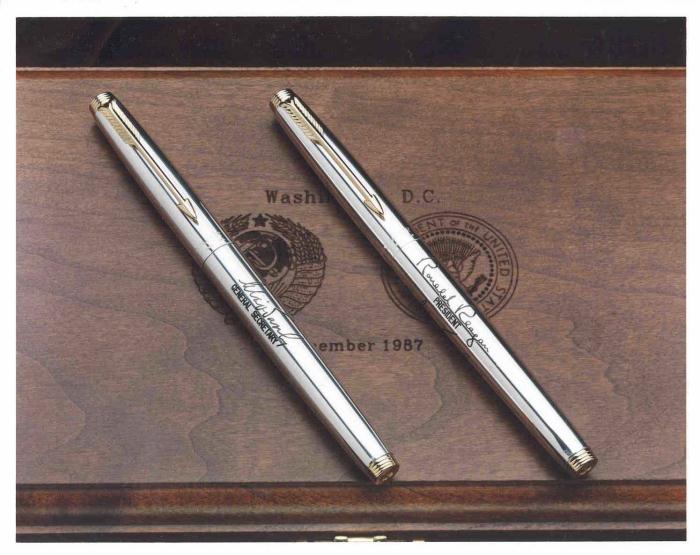Parker made these special pens to be used to sign the Intermediate-range Nuclear Forces Disarmament Treaty on December 8, 1987. The signers were US President Ronald Reagan and USSR General Secretary Mikhail Gorbachev and took place in Washington, D.C. These pens were basically the sterling silver Keepsake 75 model with special engraving of signatures of the President and General Secretary which was provided by the White House to Parker. Underneath each signature is the title of the office held by these two men.
According to Eugene Rohlman, Director of Public Relations, Parker custom produced 4 of these pens. (Remember that the Keepsake had been discontinued for several years by 1987.) I presume that 2 sets were made with the two different signatures. 2 were probably produced so that Parker could have a backup set. Of the four pens, one was given to each signing leader, Parker kept one, while the fourth was to be destroyed.
A fact sheet dated 12/10/87 prepared by Mr. Owen Jones, Parker's Director of Manufacturing, reads as follows.
Made from solid, hand-waxed American Cherry wood with fluted edges.
Royal blue interior with silver silk padded lid liner.
The lid is laser engraved in fine detail with the General Secretary's Seal and the President's Seal. The accompanying text reads: "Washington, December 1987".
"Swans-down" cleaning cloth with pinked edges is included.
Fine grade Cashmere Calf, top-grain American leather, with a fold over flap tucked through a matching clasp band.
Pouch contained accessories to enable the pen to be used as a rollerball, soft tip or fountain pen.
Made in the 75 Sterling design from solid, hand polished Sterling Silver, produced in Janesville.
The clip and trim parts are 22K gold, electroplate.
The nib is medium 18K gold.
The barrel is cut engraved with both the General Secretary's and President's signatures, which were provided by the White House. Their titles are engraved beneath the signatures in small block letters.
The pen was placed in the gift box with the cap in the back end position.
The historic treaty itself was an agreement to ban intermediate-range nuclear missiles from Europe. In all, Mssrs Reagan and Gorbachev had to sign 8 times on each of 2 documents, a total of 16 times for both men. Mr. Gorbachev's pen was a fountain pen filled with black ink, while Mr. Reagan used a medium felt-tip also filled with black ink.
As a symbolic gesture, Mr. Gorbachev offered his pen to the President upon completing the signing. This appeared to surprise the President momentarily, but then smiled broadly and accepted the gesture and reciprocated.
Questions I have about this are:
Whose name was on the pen that Parker kept?
Was the fourth pen actually destroyed?
If you know the answers, please send me email.
The promotional photo from Parker shown at the very top of this page appears to imply that each pen had a single signature. That is actually not the case per the pen's official Parker description which states:
The barrel is cut engraved with both the
General Secretary's and President's signatures, which were
provided by the White
House. Their titles are engraved beneath the signatures in small block
letters.
What was not stated is that this was done at the insistence of President Reagan. I learned this from someone at Parker who was involved with the production of this pen.
Here are some close-up pictures of the pen itself, with both signatures evident.
|
|
|
|
Tassies were dished.
|
|
|
What is interesting is the inscription on the pen cap, specifically the date code.
|
|
|
That date code of 'PI' is a strange one. Normally 3Q1987 would be represented by 'IP', with the quarter indicator 'I' preceding the letter P for the year 1987. But here the sequence is reversed and it appears that 'PI' is a way for Parker to indicate something special for the same 3Q1987 production.
President Reagan also wanted the box to be made of mesquite wood from his native California, which was lighter in color. Here is the box before it was stained and you can clearly see the grain of the wood which is similar to the marketing photo at the very top of this page.

Here are close-ups of the cap band area clearly showing the omissions: Parker name, logo, sterling silver, and country of manufacture.
The tassies on this one are slightly different too and even different between the cap and barrel. The cap tassie has a dimple in the circular depression while the barrel tassie depression is the 'dish' type..
|
|
|